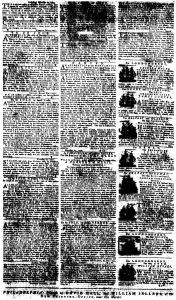
An advertisement selling land in Orange County, North Carolina. “To be SOLD in Small Tracts, ABOUT 30,000 Acres of Land, in Orange.” The Pennsylvania Gazette, December 5, 1771, Accessible Archives.
Text transcript: http://www.accessible.com/accessible/preLog?LinkType=SERIALSSOLUTIONS&ArticleID=ThePennsylvaniaGazette.GA1771120536.50127
This advertisement, located in the left column of a page of an issue of The Pennsylvania Gazette from December 5, 1771, is for the selling of a large expanse of land, divided into small portions, in Orange county, North Carolina.2 The advertisement takes the time to mention the quality of the land and crops that could be grown on it, especially wheat.2 It goes on to mention a budding settlement located at Cross Creek not far from the land that would be an added benefit for anyone wanting to profit or make a living off of growing crops.2 Before the establishment of this post, Orange county residents had to “carry their flour sometimes 180 miles by land,” presumably to find another place to conduct business.2 This advertisement gives insight into both what food ingredients were being produced in the area that would later become Chapel Hill during the late 1700’s and how these ingredients were spread and exchanged through trade.
The advertisement highlights the land’s wheat producing ability as one of its main selling points and mentions the people of Orange county taking their flour, made from wheat, to merchant stores at Cross Creek.2 The importance of this piece stems from the fact that it appears to establish that one of the main food ingredients being grown in Orange county during the 18th century was wheat and that it was made into flour to be sold or traded at stores.2 Cross Creek, now what is known as Fayetteville, grew to become, according to James Sprunt, “a great mart of trade in North Carolina.”1 James Sprunt also said that between Fayetteville and Wilmington, “there have been for a hundred years the most cordial social and business relations.”1 Though the advertisement doesn’t mention other trading locations or what residents obtained in return for their flour, the evidence of trade hints at an exchange of food and growing food network between Orange county, the rest of North Carolina, and possibly the other colonies at the time as well.
-Finley Sun
Works Cited:
- Sprunt, James, Chronicles of the Cape Fear river, 1660-1916 (Raleigh: Edwards & Broughton printing co., 1916), https://babel.hathitrust.org/cgi/pt?id=hvd.32044012986931;view=1up;seq=7
- “To be SOLD in Small Tracts, ABOUT 30,000 Acres of Land, in Orange.” The Pennsylvania Gazette, December 5, 1771, Accessible Archives. http://www.accessible.com/accessible/preLog?LinkType=SERIALSSOLUTIONS&ArticleID=ThePennsylvaniaGazette.GA1771120536.50127